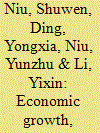|
|
|
Sort Order |
|
|
|
Items / Page
|
|
|
|
|
|
|
| Srl | Item |
| 1 |
ID:
103344


|
|
|
|
|
| Publication |
2011.
|
| Summary/Abstract |
This study was conducted to evaluate the causality between energy consumption, GDP growth and carbon emissions for eight Asia-Pacific countries from 1971 to 2005 using the panel data. The results indicate that there are long-run equilibrium relationships between these variables. Additionally, causality from energy consumption to CO2 emissions was observed generally, but there were some opposite relationships also. Parameter estimations of the panel data model indicate that there are great differences in the carbon emissions, the efficiencies of energy use, carbon emissions of unit GDP and unit energy consumption between developed and developing countries. The base carbon emissions, per capita energy consumption and efficiency of energy use in developing countries are far lower than in developed countries; however, the CO2 emissions per unit of energy use is higher. Although developing countries may reduce their CO2 emission per unit energy use, total energy consumption will rise rapidly with economic development. Thus, developing countries must determine how to undergo economic growth while conserving energy and reducing emissions. To respond to global climate change, it is necessary to develop innovative technology for energy use, transform the energy structure and conduct the clean development mechanism.
|
|
|
|
|
|
|
|
|
|
|
|
|
|
|
|
| 2 |
ID:
166379


|
|
|
|
|
| Summary/Abstract |
To facilitate energy system transition, China needs to further optimize energy structure and improve energy efficiency. Compared with physical energy consumption, effective energy consumption can better reflect the actual household energy consumption level. Based on a review of relevant literatures and official statistics, we first estimated the amounts of biogas, dung and solar energy utilized by rural households, and set up the time series of actual rural household energy consumption. The effective energy consumption was measured by the thermal efficiency of fuels from existing literatures, and main characteristics and trend of energy structure change were revealed. Finally, possible scenarios of energy use in 2030 were analyzed. The results show that per capita physical energy consumption and effective energy consumption reached 546.4 kgce and 142.5 kgce in 2015, respectively. The multiple thermal efficiency of all fuel increased from 16.02% in 1990 to 26.08% in 2015, to which the main contributor was energy structure change rather than physical energy consumption growth. The trends including total energy consumption declining and per capita energy consumption growing will continue until 2030. The shares of clean and efficient non-solid fuels in total energy consumption will further increase, whereas the share of renewable energy will decline.
|
|
|
|
|
|
|
|
|
|
|
|
|
|
|
|
| 3 |
ID:
115677


|
|
|
|
|
| Publication |
2012.
|
| Summary/Abstract |
As energy consumption is closely related to all aspects of human life, it becomes the standard by which to measure people's quality of life and the national development level. Based on the "energy ladder" hypothesis, we conducted questionnaire surveys in the Western Loess Plateau of China, and accessed a considerable amount of information about the energy usage of rural and urban households. The results show that the per capita effective heat is 323.3, 282.8, 250.0 and 123.6 kgce in the provincial capital, medium-sized cities, county towns and rural areas, respectively. The energy ladder feature is obvious. Using 719 sample data, the multiple regression analysis was conducted between per capita effective heat and two independent variables including per capita income and the attributes of energy used, the parameter estimation of the cross-quadratic model produced more significant effects. The three-dimensional graph clearly shows the differences in living standards and survival status between urban and rural households. High-income residents in urban areas consume more high-quality energy, they enjoy an affluent lifestyle. While low-income households in rural areas obtain less effective heat, and use poor quality fuels, they are still at the level of basic survival.
|
|
|
|
|
|
|
|
|
|
|
|
|
|
|
|
|
|
|
|
|